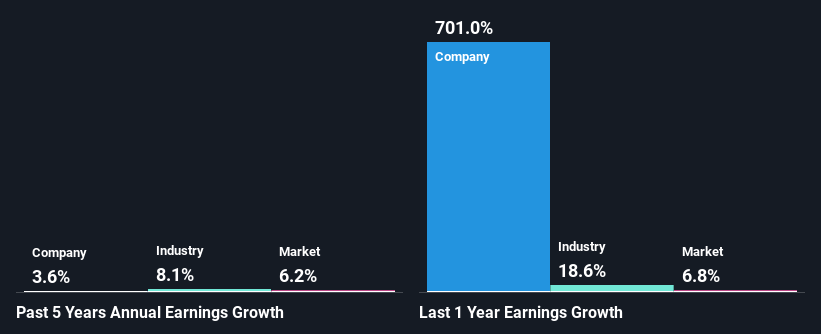Sulzer Ltd's (VTX:SUN) Financials Are Too Obscure To Link With Current Share Price Momentum: What's In Store For the Stock?
Sulzer (VTX:SUN) has had a great run on the share market with its stock up by a significant 34% over the last three months. However, we decided to pay attention to the company's fundamentals which don't appear to give a clear sign about the company's financial health. Particularly, we will be paying attention to Sulzer's ROE today.
ROE or return on equity is a useful tool to assess how effectively a company can generate returns on the investment it received from its shareholders. In short, ROE shows the profit each dollar generates with respect to its shareholder investments.
Check out our latest analysis for Sulzer
How Is ROE Calculated?
Return on equity can be calculated by using the formula:
Return on Equity = Net Profit (from continuing operations) ÷ Shareholders' Equity
So, based on the above formula, the ROE for Sulzer is:
21% = CHF230m ÷ CHF1.1b (Based on the trailing twelve months to December 2023).
The 'return' is the yearly profit. One way to conceptualize this is that for each CHF1 of shareholders' capital it has, the company made CHF0.21 in profit.
What Is The Relationship Between ROE And Earnings Growth?
So far, we've learned that ROE is a measure of a company's profitability. We now need to evaluate how much profit the company reinvests or "retains" for future growth which then gives us an idea about the growth potential of the company. Assuming all else is equal, companies that have both a higher return on equity and higher profit retention are usually the ones that have a higher growth rate when compared to companies that don't have the same features.
Sulzer's Earnings Growth And 21% ROE
First thing first, we like that Sulzer has an impressive ROE. Additionally, a comparison with the average industry ROE of 18% also portrays the company's ROE in a good light. However, for some reason, the higher returns aren't reflected in Sulzer's meagre five year net income growth average of 3.6%.Despite this, Sulzer's five year net income growth was quite low averaging at only 3.6%.Yet, Sulzer has posted measly growth of 3.6% over the past five years. This is interesting as the high returns should mean that the company has the ability to generate high growth but for some reason, it hasn't been able to do so. A few likely reasons why this could happen is that the company could have a high payout ratio the business has allocated capital poorly, for instance.
We then compared Sulzer's net income growth with the industry and found that the company's growth figure is lower than the average industry growth rate of 8.1% in the same 5-year period, which is a bit concerning.
The basis for attaching value to a company is, to a great extent, tied to its earnings growth. What investors need to determine next is if the expected earnings growth, or the lack of it, is already built into the share price. Doing so will help them establish if the stock's future looks promising or ominous. Is SUN fairly valued? This infographic on the company's intrinsic value has everything you need to know.
Is Sulzer Making Efficient Use Of Its Profits?
Sulzer has a very high three-year median payout ratio of 130%suggesting that the company's shareholders are getting paid from more than just the company's income. That's a huge risk in our books.
In addition, Sulzer has been paying dividends over a period of nine years suggesting that keeping up dividend payments is way more important to the management even if it comes at the cost of business growth. Existing analyst estimates suggest that the company's future payout ratio is expected to drop to 51% over the next three years. Despite the lower expected payout ratio, the company's ROE is not expected to change by much.
Summary
On the whole, we feel that the performance shown by Sulzer can be open to many interpretations. In spite of the high ROE, the company has failed to see growth in its earnings due to it paying out most of its profits as dividend, with almost nothing left to invest into its own business. With that said, the latest industry analyst forecasts reveal that the company's earnings are expected to accelerate. Are these analysts expectations based on the broad expectations for the industry, or on the company's fundamentals? Click here to be taken to our analyst's forecasts page for the company.
Have feedback on this article? Concerned about the content? Get in touch with us directly. Alternatively, email editorial-team (at) simplywallst.com.
This article by Simply Wall St is general in nature. We provide commentary based on historical data and analyst forecasts only using an unbiased methodology and our articles are not intended to be financial advice. It does not constitute a recommendation to buy or sell any stock, and does not take account of your objectives, or your financial situation. We aim to bring you long-term focused analysis driven by fundamental data. Note that our analysis may not factor in the latest price-sensitive company announcements or qualitative material. Simply Wall St has no position in any stocks mentioned.

 Yahoo Finance
Yahoo Finance 
